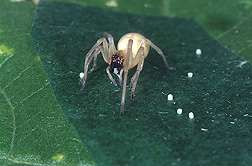Beneficial Nocturnal Insects Help Combat Pests in Texas

(PhysOrg.com) -- Agricultural Research Service (ARS) scientists in Texas are staying up late to search for beneficial insects that feed on crops pest eggs at night.
For the past eight years, ARS entomologist Bob Pfannenstiel and other ARS scientists have been studying the feeding habits of these nocturnally active predators in the Lower Rio Grande Valley in south Texas. The researchers at the ARS Beneficial Insects Research Unit (BIRU) in Weslaco, Texas, have conducted day and night field tests on insects that feed on the eggs of lepidopteran insects such as Helicoverpa zea (the cotton bollworm/corn earworm) and Spodoptera exigua (the beet armyworm). These pests attack corn, cotton, soybeans and other crops.
The predators that feed on the eggs during the day are very different from those that feed at night, and nighttime predation can be much more important. Two nocturnal predators have stood out from the rest: cursorial (running) spiders, mainly the species Hibana futilis, and the exotic Asian cockroach (Blattella asahinai).
Cursorial spiders consume significant numbers of moth eggs in row crop foliage, with about 99 percent of their predation occurring after dark. These spiders are particularly important in cotton, where they benefit from consuming the plant’s sugars. Since 2006, when the exotic Asian cockroach reached south Texas, it has been the most important late season predator of lepidopteran eggs in soybean.
Laboratory and greenhouse studies by BIRU scientists, including Shoil Greenberg and Randy Coleman, have shown that the spiders prey on other cotton pests, including the cotton fleahopper, Pseudatomoscelis seriatus, and the cotton plant bug, Creontiades signatus.
The cursorial spider has a greater impact on the cotton fleahopper, which is smaller than the cotton plant bug. This may suggest that the spider has the potential to be an important predator of cotton fleahopper.
BIRU scientists have also frequently observed the cotton fleahopper as a mostly nocturnal predator of lepidopteran eggs in cotton, meaning that as an omnivore, it can act as both pest and a predator. Many plant bugs feed on both plants and prey, although in general it is not well understood how important predation is in their life history.
Read more about this research in the October 2009 issue of Agricultural Research magazine.
Provided by USDA Agricultural Research Service















